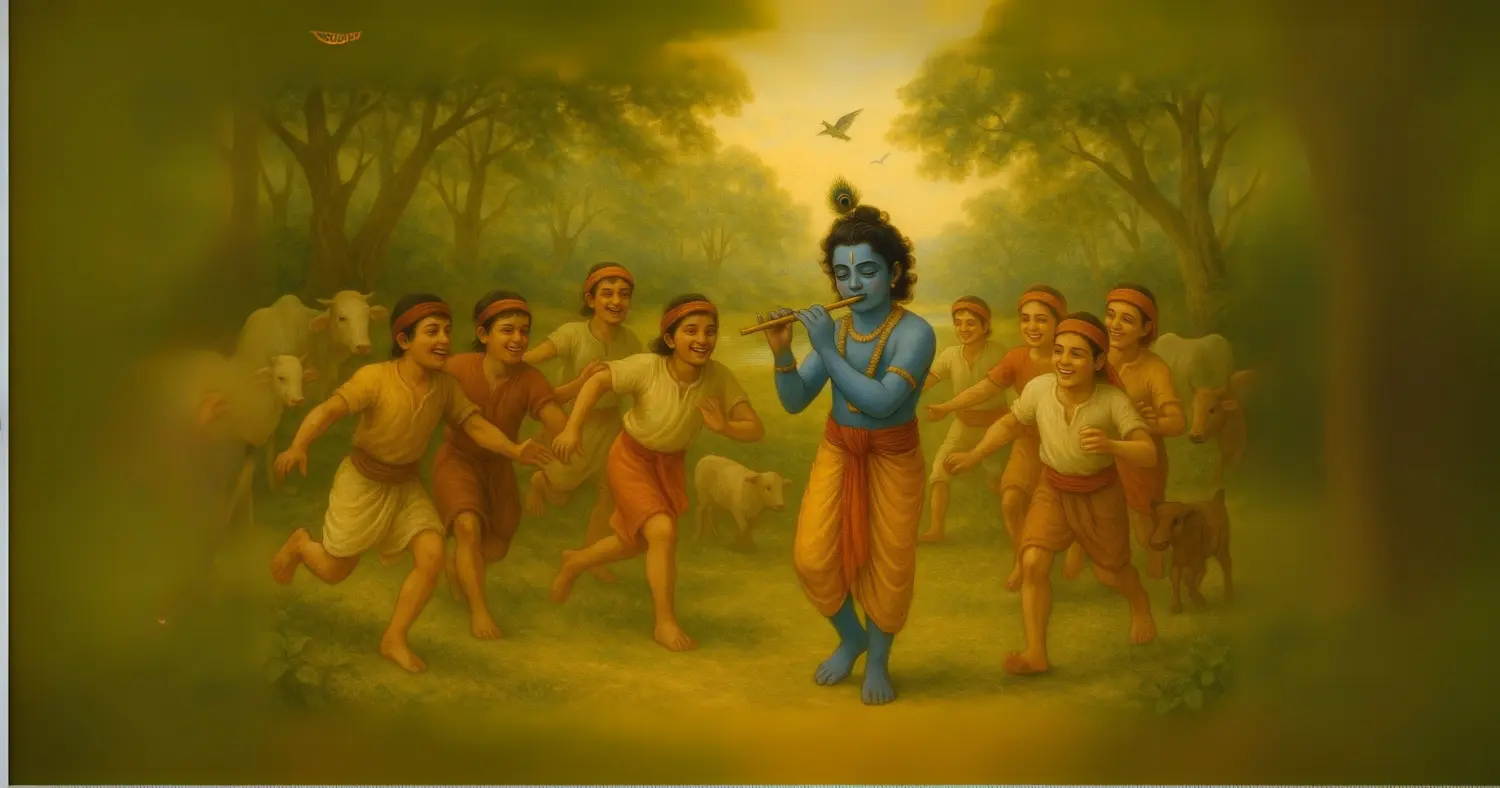Table of Contents
Sri Krishna: The Vishnu Avatara, Embodiment of Dharma and Prema
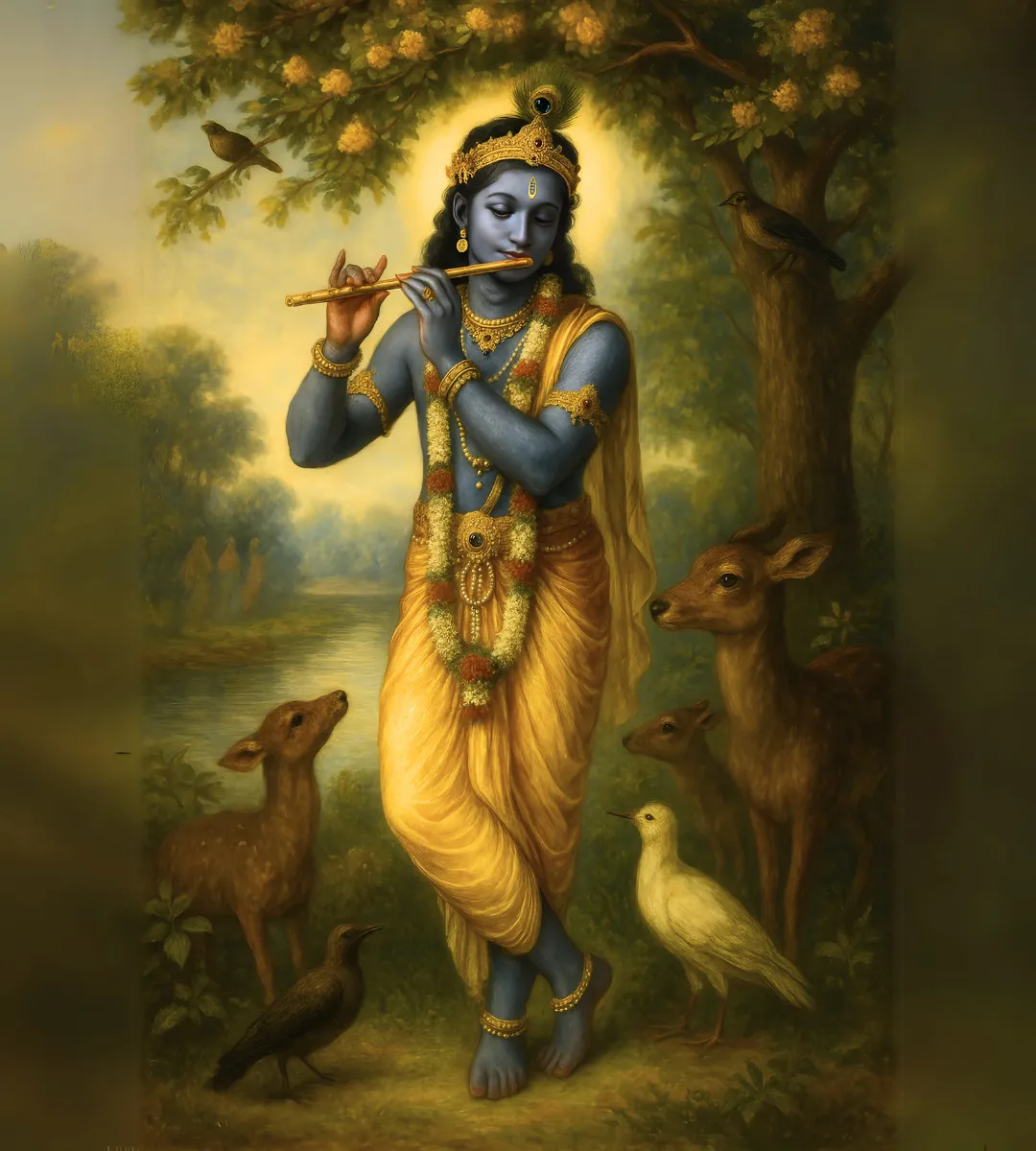
Sri Krishna is the eighth avatar of Bhagavan Vishnu, He personifies divine love, immaculate wisdom, and represents the very root of Prema or Divine Love, unheard of on the material platform. His descent was in the Dvapara Yuga. His life was filled with sublime leela (divine play), profound spiritual finesse that strangely gelled with a pragmatic yet righteous polity. He is not just a deity worshipped by millions. He represents that which is timeless, beyond the rules of known sciences and is a spiritual force that continues to guide seekers through the entanglements of karma, duty, and devotion.
Who is an Avatara? Why Does Lord Vishnu Take Form?
The term Avatara (अवतार) means “descent” or a divine being descending from the spiritual realm who visits the material world to restore cosmic balance. In the Sanatana Dharma tradition, Lord Vishnu, the sustainer of the universe, takes various forms to protect dharma (righteousness), destroy adharma (unrighteousness), that shall result in uplifting humanity, at least temporarily. The purpose is to give lessons to the upcoming generations of the human race, people who are ready to gain spiritually and morally, which can save them from several forthcoming pitfalls.
As stated in the Bhagavad Gita (4.7–8):
“Yada yada hi dharmasya glanir bhavati bharata
Abhyutthanam adharmasya tadatmanam srjamy aham
Paritranaya sadhunam vinashayacha dushkritam
Dharma-samsthapanarthaya sambhavami yuge yuge”
भगवद्गीता ४.७–८
४.७
यदा यदा हि धर्मस्य ग्लानिर्भवति भारत।
अभ्युत्थानम् अधर्मस्य तदाऽऽत्मानं सृजाम्यहम्॥
४.८
परित्राणाय साधूनां विनाशाय च दुष्कृताम्।
धर्मसंस्थापनार्थाय सम्भवामि युगे युगे॥
Translation: Whenever righteousness declines and unrighteousness rises, I manifest Myself. To protect the good, destroy the wicked, and reestablish dharma: I incarnate, age after age.
Thus, Sri Krishna appeared not just to participate in the worldly drama but to alleviate the woes of the meek and humble, show them a path through the thick fog of debauchery and savagery of Kaliyuga, for the upliftment of all beings.
What is Leela :The Divine Play of Consciousness?

Leela simply means the spontaneous, blissful play of the Divine. Unlike human actions born from ego, ambition, or necessity, Sri Krishna’s actions are effortless, detached, and filled with transcendental fervor.
His stealing butter, dancing with the Gopis, or lifting Govardhan hill, all appear like miracles or childlike acts. But every gesture reveals profound truths: the nature of divine love (rasa), the loving pulverization of the illusion of ego (ahamkara), and the playful unfolding of the cosmos.
In Sri Krishna’s leela, even conflict becomes a tool for consciousness. The battlefield becomes a classroom. The palace becomes the arena of humility. In every act, he reminds the jeeva or spirit soul that this world is both real and unreal, a mirror of our inner state floating over the continuous river-flow of time, place and circumstance.
Lord Krishna’s Clean Politics: The Dharma of Strategy
Unlike worldly politics driven by manipulation or greed, Sri Krishna’s politics was rooted in dharma and cosmic justice. He never ruled as a king, yet kings bowed to his counsel. His diplomacy during the Mahabharata era remains unsurpassed.
As the Peace Envoy, Bhagavan offered peace to the Kauravas, requesting just five villages. When refused, it showed the Lord’s commitment to postpone war as much as possible and only choose it if dharma necessitated it.
Thus Sri Krishna gave us a lesson that we should never be the aggressors, aggression should only be used as a tool for protection or defense and never to usurp other’s right to exist. Many blame Bhagavan as the perpetrator of war but no one bothers to understand the importance of righteous strategy, something which the modern world misses, even after the great Lord has set the topmost example of patience and aggression at the most apt times.

He displayed a Charioteer’s Humility by becoming subservient even to a Jiva like Arjuna. Here is the Supreme Being taking instructions from a being who depended on Him. Though divine, he chose the humble role of Arjuna’s charioteer, demonstrating servant-leadership as the highest form of strength.
As the Protector of Dharma Sri Krishna never fought with weapons in the war, but orchestrated the Pandavas with Dharmic instructions of the highest kind, ensuring justice for Draupadi, and upholding the dignity of women and sages. Thus he re-established moral order.
This was not politics of power, but politics of principle, blending vision with action, compassion with clarity.
Karma, Duty, and Devotion: The Trinity of Bhagavan Krishna’s Teaching
One of Sri Krishna’s greatest contributions is the harmonization of karma (action), dharma (duty), and bhakti (devotion):
Karma: Sri Krishna taught that every being must act, but without selfish indulgence. Even he, though complete, acts for loka-sangraha, the welfare of all beings.
Duty: Arjuna was instructed not to run from his Kshatriya duty. Bhagavan urged him to stand up, not for ego, but for Truth, for Righteousness. Duty, when aligned with higher principles, becomes sacred.
Devotion: Above all, Sri Krishna taught that action without love is dry. He encouraged surrender (sharanagati) “Offer every act to Me, see Me in all, and you shall come to Me” (Gita 9.27).
Through this integration, Bhagavan provides a universal path: act with dharma, serve with humility, and love with total surrender. In essence, Sri Krishna is not just a historical figure but an eternal archetype of the highest wisdom engaged in worldly affairs. He shows us how to live with balance, anchored in the soul but active in the world. Whether through the flute of Vrindavan or the chariot of Kurukshetra, he sings the same eternal song: Live joyfully, act righteously, and love unconditionally.
The Birth of Sri Krishna: Light Born Amidst Chains
Sri Krishna was born at midnight, in the depths of darkness, inside a prison cell in Mathura. It was the Ashtami Tithi of the Krishna Paksha (waning moon) in the sacred month of Bhadrapada, under the star Rohini, known for beauty, charm, and the nourishing nature of the Divine Feminine.
But this was no ordinary birth. It was a cosmic declaration: Dharma does not die; it simply waits for the right moment to reappear, often where it is least expected.
Why Was Krishna Born in a Prison?
The prison symbolizes the shackles of ego, fear, and ignorance, the very forces that enslave the human soul. Sri Krishna’s birth in a jail is no coincidence. It is the eternal truth that the Divine takes birth precisely where it is most needed: in bondage, in darkness, in despair.
Devaki and Vasudeva, despite their royal lineage, were imprisoned by Devaki’s cousin. Their divine child was born not in a palace, but in a locked cell, watched over by guards, amidst silence and fear. This tells us something profound: Divinity is not elitist.
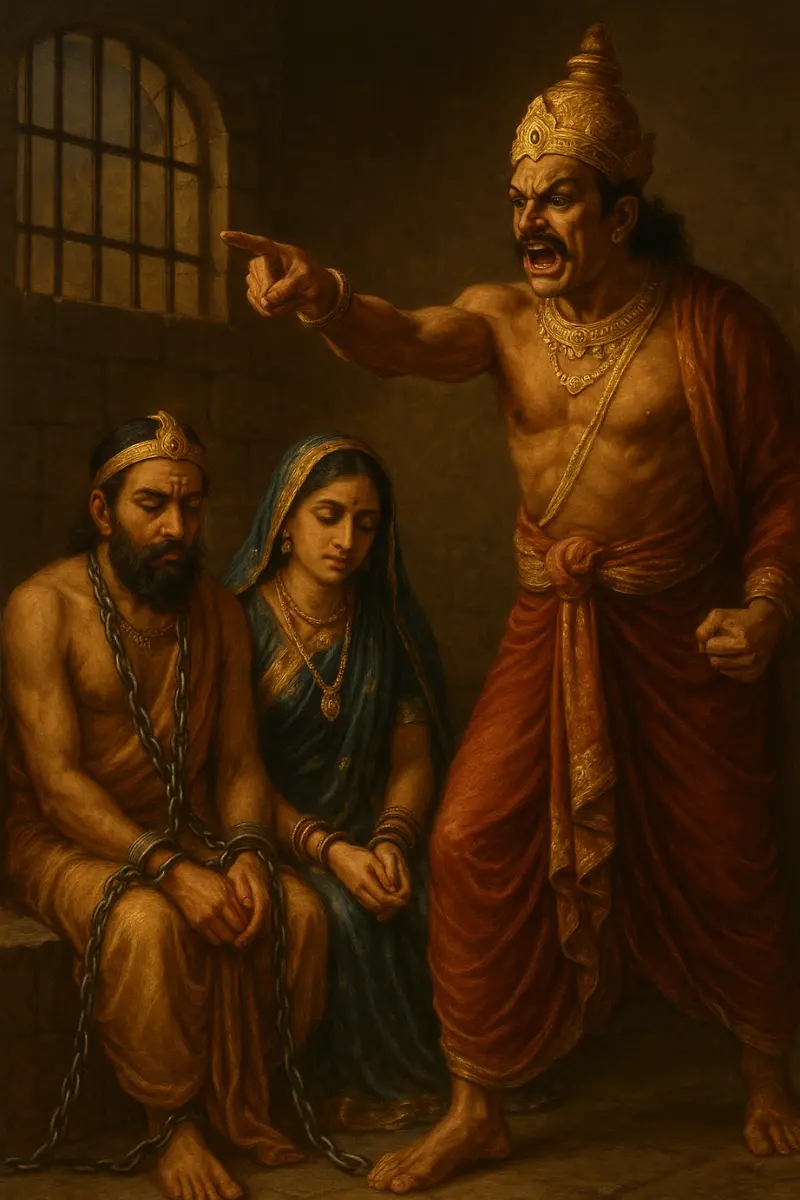
It does not shy away from grime, oppression, or shadow. It descends into it. It appears when darkness appears endless, when hopelessness sets in completely. A similar birth of the Divine is the birth of the great devotee Avatara of Lord Krishna, Sriman Chaitanya Mahaprabhu who appeared on an eclipsed full moon night in the land of Mughal oppression of erstwhile Bengal, when religion was at its lowest ebb, a time when pseudo-religion proliferated and nefarious activities passed as religion.
When dharma is caged, when the soul is held captive by forces of adharma, the avatar appears, within us and around us.
The Midnight Birth: Symbolism of Time and Tithi
Midnight is the time of greatest stillness. All is silent. The sun has completely receded, and the moon is also absent from sight in the Krishna Paksha. Symbolically, this is the darkest hour, externally and internally.
Yet it is in this silence, in this emptiness, in this void, that the Supreme makes Himself known. This is the moment when the ego sleeps and suddenly the soul awakens through the sheer influence of Grace. Sri Krishna was not born in daylight for the world to celebrate. He was born in darkness, silently, when the world slept.
The Ashtami Tithi, being the eighth day, holds deep tantric symbolism. It represents the struggle between chaos and cosmic order, a battlefield where inner and outer demons must be confronted. Hence, Sri Krishna’s birth on Ashtami is not random; it is the perfect portal for divine intervention. Ashtami represents the number 8 which also represents Saturn. It is dreaded because the planet does not tolerate Adharma. No wonder the epitome of ultimate Dharma appeared on this Tithi, at the darkest hour.
Rohini Nakshatra: The Star of Grace
Rohini is ruled by Chandra (Moon) and associated with fertility, beauty, enchantment, and inner nourishment. It is the most beloved nakshatra to Lord Krishna. It reveals that although He was born amidst terror, His essence would be charming, attractive, and magnetic, the embodiment of ananda (bliss).
Even in bondage, His energy would not be that of sorrow, but of sweetness , showing that joy is not circumstantial, it is existential.
What Did Kamsa Represent?
Kamsa was not just a cruel king; he was the archetype of adharma in an apparent human form, wholly demoniac who represented the uncontrolled mind, the tyrant ego, the paranoia of power.
He feared the prophecy of death, and in that fear, he killed innocents. Like the deluded mind, he tried to control destiny through violence. He represents the inner Kamsa, the fear-based intellect that imprisons the soul (Devaki) and its truth-bearing consort (Vasudeva).
But what Kamsa failed to understand is this: You can kill forms, but not truth. You can imprison bodies, but not dharma.
Thus, Sri Krishna’s birth is the beginning of the fall of ego, the death of fear, and the reclaiming of divine balance.
The State of Dharma at the End of Dvapara Yuga
By the end of Dvapara Yuga, Dharma had been reduced to one leg, symbolically limping, fractured, and weak. Society was divided, virtue was commercialized, kings were driven by lust, sages were mocked, and women were dishonored.
In this fallen world, Dharma no longer resided in the palaces or temples. It was caged, silent, unseen. And yet, in that moment of collapse, the Eternal entered once again, not to judge, but to uplift. Sri Krishna’s birth did not immediately change the world, but it planted a seed, a seed that would flower in Kurukshetra, in the hearts of Gopis, and in the minds of seekers across millennia.
The Birth of Sri Krishna: A Message to All Sadhakas
For the spiritual seeker, Sri Krishna’s birth is not a tale of the past, it is a reminder that every soul contains a prison, and every prison holds the potential of Sri Krishna. The moment you invoke truth amidst your inner darkness, He is born again, within your own heart.
Let us remember:
Dharma is never truly destroyed. It waits mummified.
And when the time is ripe, even behind locked doors,
The Divine shall spurt forth.
The Timeless Philosophy of Sri Krishna in Sanatana Dharma

Sri Krishna’s philosophy is not just a historical or mythological doctrine; it is a living, breathing wisdom system that speaks to the deepest mechanics of human life, choice, struggle, and transformation. His teachings are distilled in the Bhagavad Gita cutting across eras, societies, and temperaments because they address not just external morality, but the inner architecture of consciousness.
Purna Purusha: The Complete and Final Incarnation
In Sanatana Dharma, Purna Purusha means the “Complete Being” : one who embodies all aspects of divinity in their entirety. Sri Krishna is considered the Purna Avatara of Bhagavan Vishnu, not just because of his supernatural acts or divine birth, but because he unites within himself all the attributes of Godhead:
Jnana (supreme knowledge)
Bala (strength and courage)
Aishvarya (divine opulence and majesty)
Virya (heroism and prowess)
Shakti (creative power)
Tejas (spiritual brilliance)
He is not a partial expression of Bhagavan who displayed part of His glories like how Sri Rama displayed Dharma, Narasimha displayed fatherly protection, Sri Vamana who established cosmic balance and so on. Rather, Sri Krishna in His 125 years of earthly existence displayed all aspects of Godhead: the playful, personal, philosophical, and transcendent dimensions of the Divine, all in one.
As Vedavyasa notes in the Bhagavatam, “Krishnas tu Bhagavan svayam” (कृष्णस्तु भगवान् स्वयं) Sri Krishna is God Himself, not merely a representative or messenger.
Why Sri Krishna’s Teachings Transcend Time
Lord Krishna’s philosophy transcends time because it does not rely on cultural, geographical, or religious boundaries. It addresses the existential dilemmas that arise within every human being:
“What is my duty?”
“Should I fight or retreat?”
“How can I act without being bound by action?”
“What is the self?”
“Who am I?”
These are not questions of a particular age; they are built into the very wiring of human consciousness. And Sri Krishna answers them with penetrating clarity.
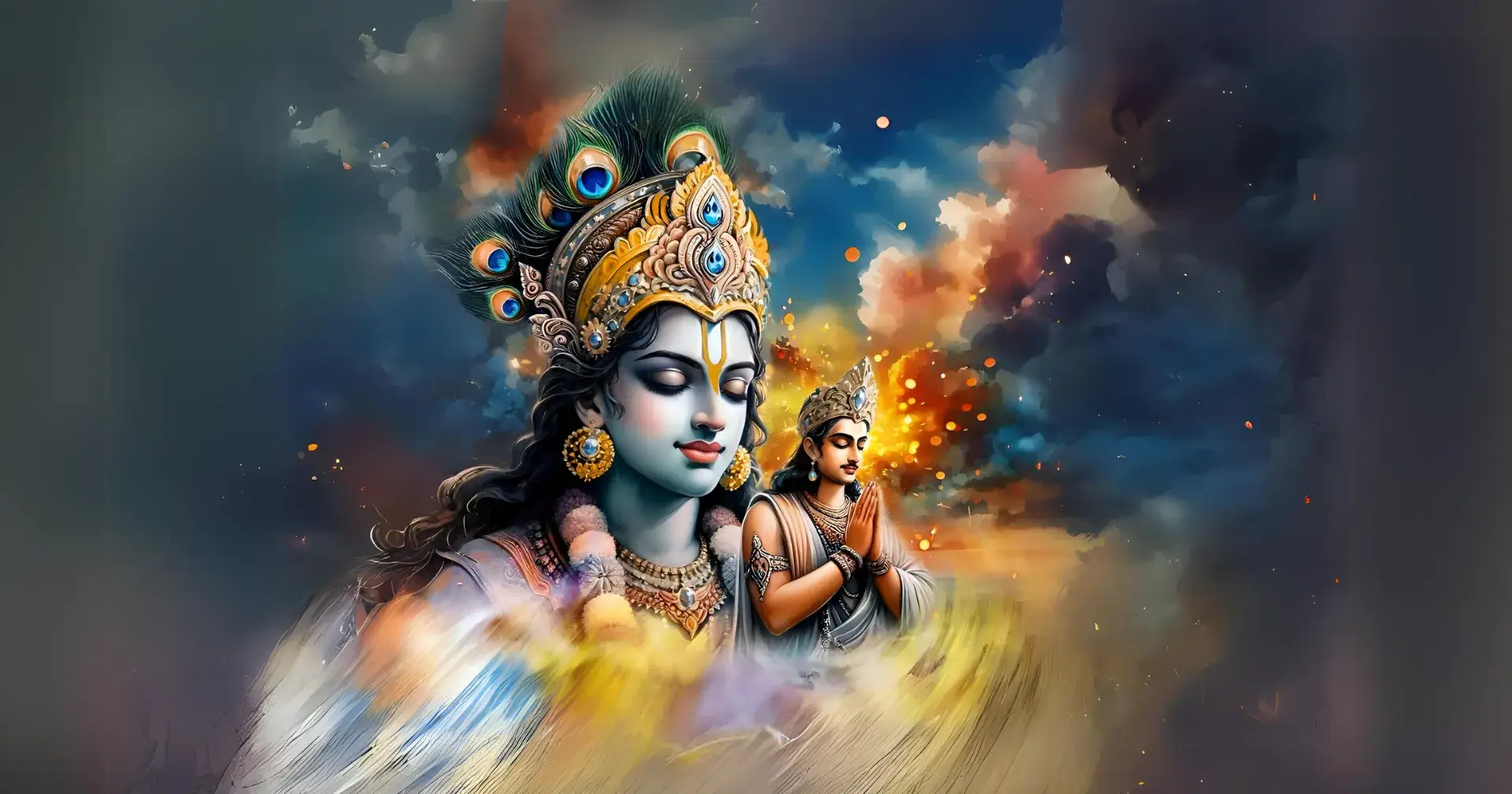
He teaches Nishkama Karma: action without attachment to results, because the root of suffering is expectation and identification with the fruits of action. He teaches Bhakti, because the restless heart seeks something to surrender to, something larger than ego. And he teaches Jnana, because ignorance (avidya) is the root of bondage.
In doing so, he doesn’t command from above, but engages from within, as a friend, as a guide, as the voice of one’s own higher self.
Exposing Human Frailty with Compassion
Unlike rigid doctrines that shame human weakness, Sri Krishna meets frailty with realism and Grace. When Arjuna breaks down on the battlefield, torn by attachment, confusion, and despair, the Lord does not condemn him. He doesn’t label Arjuna as weak. He simply reflects the truth:
“You are grieving for something which does not deserve grief… The wise grieve neither for the living nor for the dead.” (Gita 2.11)
His teachings expose the mechanisms of fear, ego, attachment, and ignorance, not to destroy the person, but to purify the inner lens through which life is seen. He invites us to see ourselves as the eternal Atman, not the fleeting body or role.
He doesn’t ask us to subjugate emotion, but to align it with wisdom, to act with presence and clarity.
Healing the Inner Conflict: Karma, Bhakti, and Jnana
Lord Krishna provides a threefold medicine to the human soul:
Karma Yoga: Fixes passivity, self-centeredness, and mental inertia by aligning action with dharma and detachment.
Bhakti Yoga: Melts arrogance, loneliness, and false independence by cultivating surrender to the Divine Will.
Jnana Yoga: Dispels delusion and ignorance, empowering the soul to discriminate between the eternal and the transient
Together, they address every layer of human struggle, physical, emotional, intellectual, and spiritual.
A Philosophy for All Yugas, Especially Kali Yuga
Sri Krishna’s philosophy is especially potent in Kali Yuga because it does not demand perfection. It demands sincerity. He assures in the Gita:
“Even a little practice of this dharma saves one from great fear.”
“Even if a person of sinful conduct worships Me with devotion, he should be regarded as righteous.”
This compassion, this inclusiveness, this willingness to engage the broken-hearted, the confused, and the impure makes Bhagavan’s teaching the most psychologically and spiritually healing message for our times.
Sages During His Times and the Views of Garga and Others
During the time of Sri Krishna’s incarnation, several great sages walked the earth, Garga Muni, Akrura, Narada, Durvasa, and Vedavyasa, among others. These were not ordinary beings; they were seers of Truth who understood the divine drama unfolding through the Lord’s life. Each offered unique perspectives on His identity, revealing the depth and multidimensional nature of Krishna Avatar.
Garga Muni, The Seer of Divine Identity
Garga Muni, the revered family priest of the Yadavas and a direct descendant of Sage Bhrigu, played a pivotal role in Lord Krishna’s early life. He was entrusted with performing the naming ceremony of Sri Krishna and Sri Balarama in secret, to protect the divine child from Kamsa’s wrath. This event is described in the Garga Samhita, a Vaishnava scripture rich in leela narratives, metaphysical discussions, and praises of Sri Krishna and Srimati Radharani.
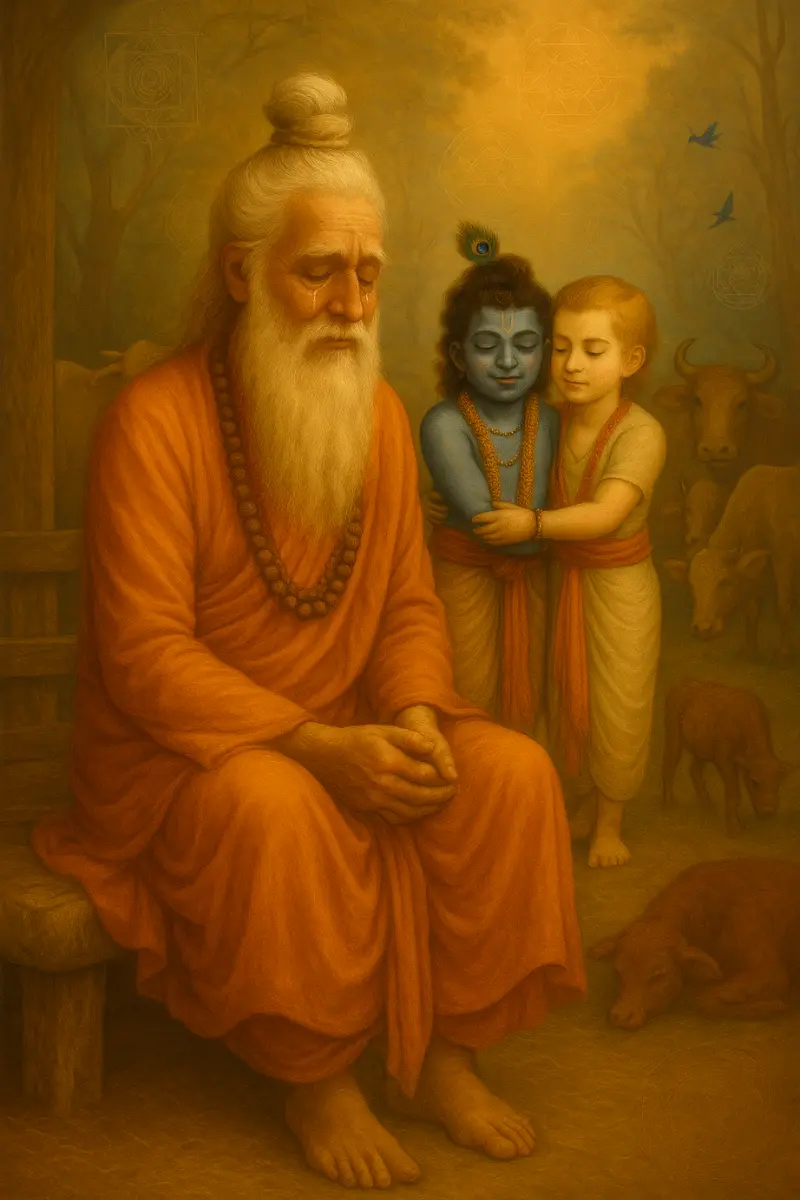
During this sacred rite, Garga Muni prophetically told Nanda Maharaj:
“This child has taken birth in every yuga with different complexions, and in this age, He appears in blackish-blue form. He will be the cause of joy to all people. He is Narayana Himself, born again to protect dharma.”
Sri Garga’s words were not flattery. They were a mystical recognition that Sri Krishna was not simply a prince or prodigy, but the very Supreme Being.
The Garga Samhita holds a special place in the Bhakti tradition, especially among Gaudiya Vaishnavas, as it describes the esoteric and devotional aspects of of the Lord’s pastimes in Vrindavan, Mathura, and Dwaraka. It also includes elaborate teachings on mantras, yantras, and the spiritual significance of Radha-Krishna worship.
Akrura: The Devotee with Doubt Transformed by Vision
Akrura, a nobleman in the Yadava dynasty, was initially unsure of Lord Krishna’s divinity. Akrura saw the Him as an extraordinarily gifted prince, endowed with virtues and charisma, but still within the framework of a mortal hero.
However, his perspective dramatically shifted when Bhagavan invited him to Vrindavan and revealed to him the Vishwaroopa, the Cosmic Form. Akrura beheld in Sri Krishna the entire universe, the devas, the lokas, the flow of time, the creation and dissolution of worlds. Overwhelmed, Akrura fell at Bhagavan’s feet and declared:
“You are the beginningless Supreme Lord. This entire world rests in You, and You remain untouched by it.”
Thus, the contrast between Garga’s certainty and Akrura’s transformation reflects how Sri Krishna’s divinity is revealed gradually, sometimes through knowledge, and sometimes through Grace.
Together, these sages affirm that Sri Krishna is both near and far, visible and invisible, a child to some and God to others. Their testimonies form a spiritual mosaic that continues to guide Bhaktas, Yogis, and seekers across centuries.
Sri Krishna and the Mahabharata: A Blueprint for the Kaliyuga Mind
The Mahabharata is not merely an epic; it is a divine orchestration by Sri Krishna to prepare humanity for the coming age of Kali, an age marked by moral decline, spiritual confusion, and internal conflict. While the war at Kurukshetra appears to be a dynastic battle, Sri Krishna’s presence reveals a far deeper spiritual agenda: to lay bare the psychological and ethical dilemmas of the human condition and offer eternal principles to navigate them.
Why Bhagavan Orchestrated the Mahabharata
Sri Krishna could have prevented the war. He tried. As a peace envoy to the Kaurava court, He asked for just five villages for the Pandavas. But adharma, in the form of Duryodhana’s ego and greed, refused even that. This refusal was not accidental; it was destined, for Sri Krishna did not come to stop the war, He came to reveal truth through it.
In the unfolding of Mahabharata, he used the battlefield as a mirror for the inner war every human must face. The fight between Pandavas and Kauravas represents the conflict between dharma and adharma, self-mastery and ego, wisdom and delusion. These forces are not “out there”, they live within every heart.
The Mahabharata was created to be timeless, a scripture for the soul, especially for those in Kali Yuga, who lack access to complex Vedic rituals or the presence of living Rishis. It is Bhagavan’s gift of practical spirituality for the householders, the broken, the confused, the modern seeker.
The Bhagavad Gita : The Eternal Light in the Age of Darkness
At the center of the Mahabharata lies the Bhagavad Gita, a conversation not of conquest, but of consciousness. Here, Lord Krishna speaks to Arjuna not as a king or commander, but as the inner voice of divine reason.
He teaches Karma Yoga, to overcome passivity and selfish action; Bhakti Yoga, to dissolve the ego in love for the Divine; and Jnana Yoga, to know the imperishable Self beyond roles and outcomes.
These teachings are meant for the Kali Yuga mind, which is restless, anxious, and fragmented. Bhagavan does not ask for blind obedience, he asks for clarity, courage, and surrender with understanding.
Every Character as a Mirror to Modern Humanity
Lord Krishna crafted the Mahabharata in such a way that every major character is a psychological archetype, revealing flaws and strengths of human nature:
Duryodhana represents unchecked ego, entitlement, and the inability to accept truth.
Karna symbolizes misplaced loyalty and how unresolved wounds distort dharma.

Bhishma, though noble, is attachment to vows at the cost of truth.
Draupadi, the awakened feminine, calls for justice and cosmic balance.
Yudhishthira, though righteous, struggles with self-doubt and overthinking.
Arjuna, the ideal sadhaka, is torn between emotion and duty, until he surrenders.
By assigning roles to such diverse and complex characters, Lord Krishna allowed humanity to see its own dilemmas played out in epic scale, making the Mahabharata not a story of the past, but a map of eternity.
The Unseen Warrior: Dharma Without Weapons
Despite being the Supreme Being, Lord Krishna vowed not to pick up a weapon during the war. Yet he was the most powerful warrior on the field, wielding the greatest weapon of all: wisdom.
He guided the Pandavas, broke Drona’s spirit through ethical maneuvering, exposed Karna’s past, protected Draupadi’s honor, and ensured the downfall of adharma, all without ego, ambition, or glory.

His message was simple: “Do your duty. Do not be attached to the outcome. Surrender to Me, and I shall free you.”
A Living Scripture for the Modern Age
In the chaos of Kaliyuga, with misinformation, moral collapse, and inner confusion, Sri Krishna’s Mahabharata becomes a mirror, a manual, and a mantra.

We don’t need to fight a physical war. But we are all in Kurukshetra daily, in our homes, workplaces, relationships, and minds. And just like Arjuna, we too must hear the Gita within, spoken not from the sky, but from the charioteer seated in our own hearts. It is ideal to hear the Gita from a God-realized Sage, Sadhu or Guru. It is well-known in the spiritual circles: “Just as one should not drink wholesome milk touch by the tongue of a poisonous snake, one should not hear the Gita from an individual who is servant to even one of the six passions namely Kama (Lust), Krodha (Anger), Lobha (Greed), Moha (Illusion), Mada (Self-Pride) and Matsarya (Envy).
Lord Rama vs. Lord Krishna: A Wholehearted Comparison

Lord Rama is Maryada Purushottama, the epitome of righteous conduct, while Sri Krishna is Leela Purushottama, the master of divine play. Sri Rama’s life is structured, ideal, and unwavering in dharma even at personal cost. Sri Krishna’s life, though seemingly paradoxical, reflects higher dharma, where results, compassion, and context guide actions.
When to Follow Sri Rama and When to Apply Krishna’s Principles
Follow Lord Rama when facing ethical dilemmas in personal life, be it familial duties, truthfulness, or sacrifice. Follow Krishna when life demands diplomacy, deeper understanding of karma, or action in complex situations. The same seeker must be both disciplined like Sri Rama and wise like Sri Krishna.
Importance of Bhagawan Rama and Bhagawan Krishna in a Sadhaka’s Life
For a sadhaka, Sri Rama teaches surrender, discipline, and ideal living. Sri Krishna brings spiritual spontaneity, joy, and the art of balancing detachment with intense action. Together, they offer a complete map for inner transformation.
Sri Krishna in the Kaliyuga
Sri Krishna is most relevant in Kaliyuga. His message of bhakti, karma yoga, and forgiveness addresses modern complexities. His names alone, Govinda, Gopala, Madhava, purify the mind. No wonder Kali-Santarana Upanishad recommends chanting “Hare Krishna Hare Krishna Krishna Krishna Hare Hare Hare Rama Hare Rama Rama Rama Hare Hare” as the best path in this age.
Sampradayas that Promote Sri Krishna’s Life
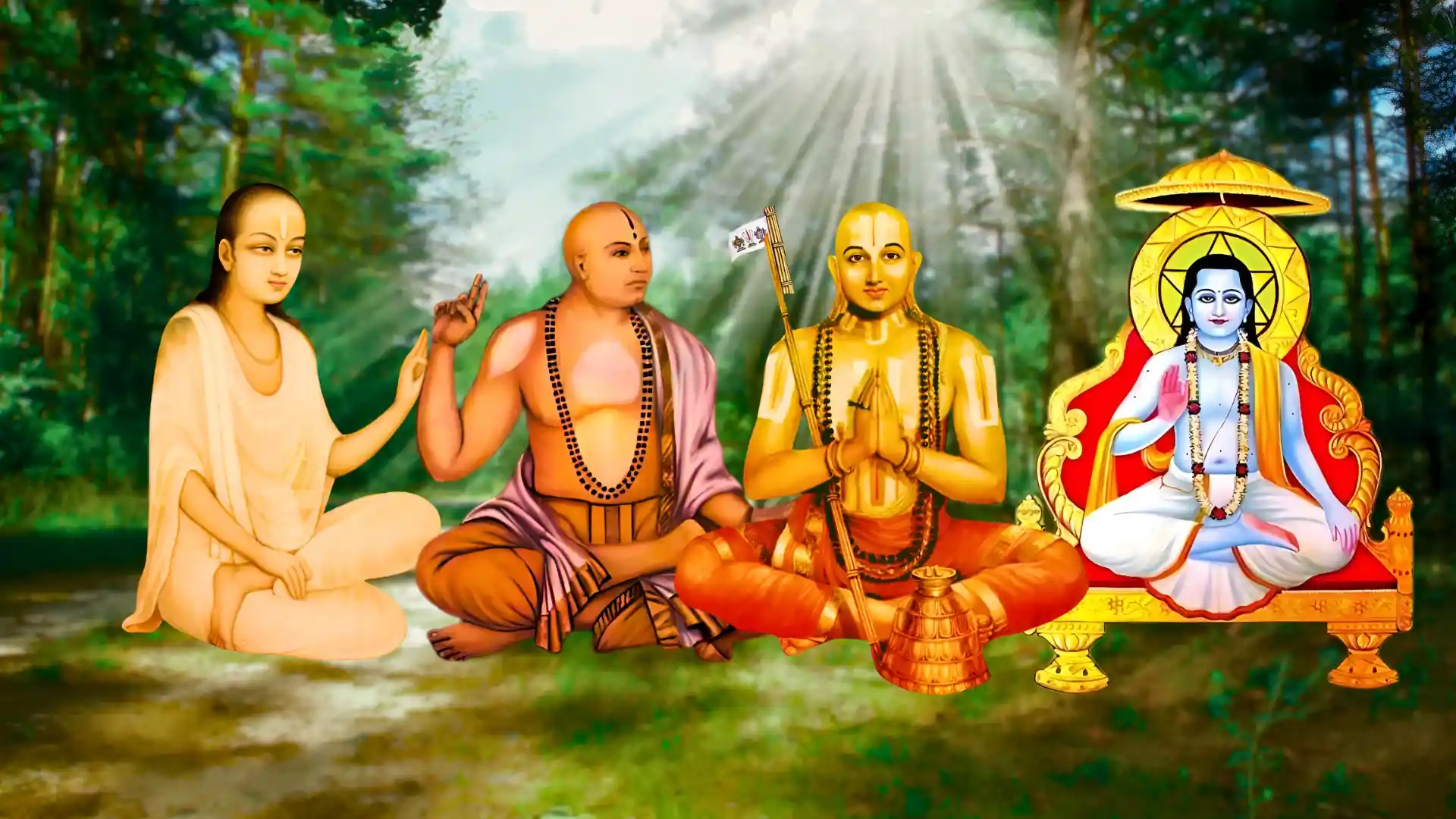
- Gaudiya Vaishnavism – Spearheaded by Sriman Chaitanya Mahaprabhu, focusing on Krishna Bhakti through Harinam Sankirtan.
- Vallabha Sampradaya – Founded by Sri Vallabhacharya, celebrating Sri Krishna as the divine child.
- Nimbarka Sampradaya – Emphasizes Sri Sri Radha-Krishna devotion.
- Sri Vaishnava Sampradaya – Led by Sri Ramanuja, viewing Krishna as the supreme personality of Godhead.
- Sri Madhwa Sampradaya- Sri Madhwacharya promoted Vishnu Bhakti and personally he worshipped Sri Krishna and greatly promoted Krishna Bhakti.
The Sri Krishna Yantra: Interpretation and Power
The Sri Krishna Yantra is a direct representation of Bhagavan Krishna and the presence of the Yantra in one’s home directly represents Bhagavan’s direct presence in your home. The Grace on a person who worships the Krishna Yantra is incalculable. Possessing the Krishna Yantra is compared to possessing a Chintamani, a rare stone that can fulfill all of one’s legitimate wishes that can offer one guidance and direction and one that can play the same role as Sri Krishna played in the life of Arjuna.
The Krishna Yantras have many forms of representations. One of the many representations is included below. This is a copper Yantra. But it is best to possess a Yantra made out of Bhaoj Patra (Bark of a Himalayan Birch Tree). These Yantras can be a thousand times more efficient and powerful because of the Mantra based potentized etching of the Yantra with energized natural elements, by a competent Master. Such Bhoja Patra etchings cannot be compared with Market products which are produced in mass and not created as personalized Yantras.
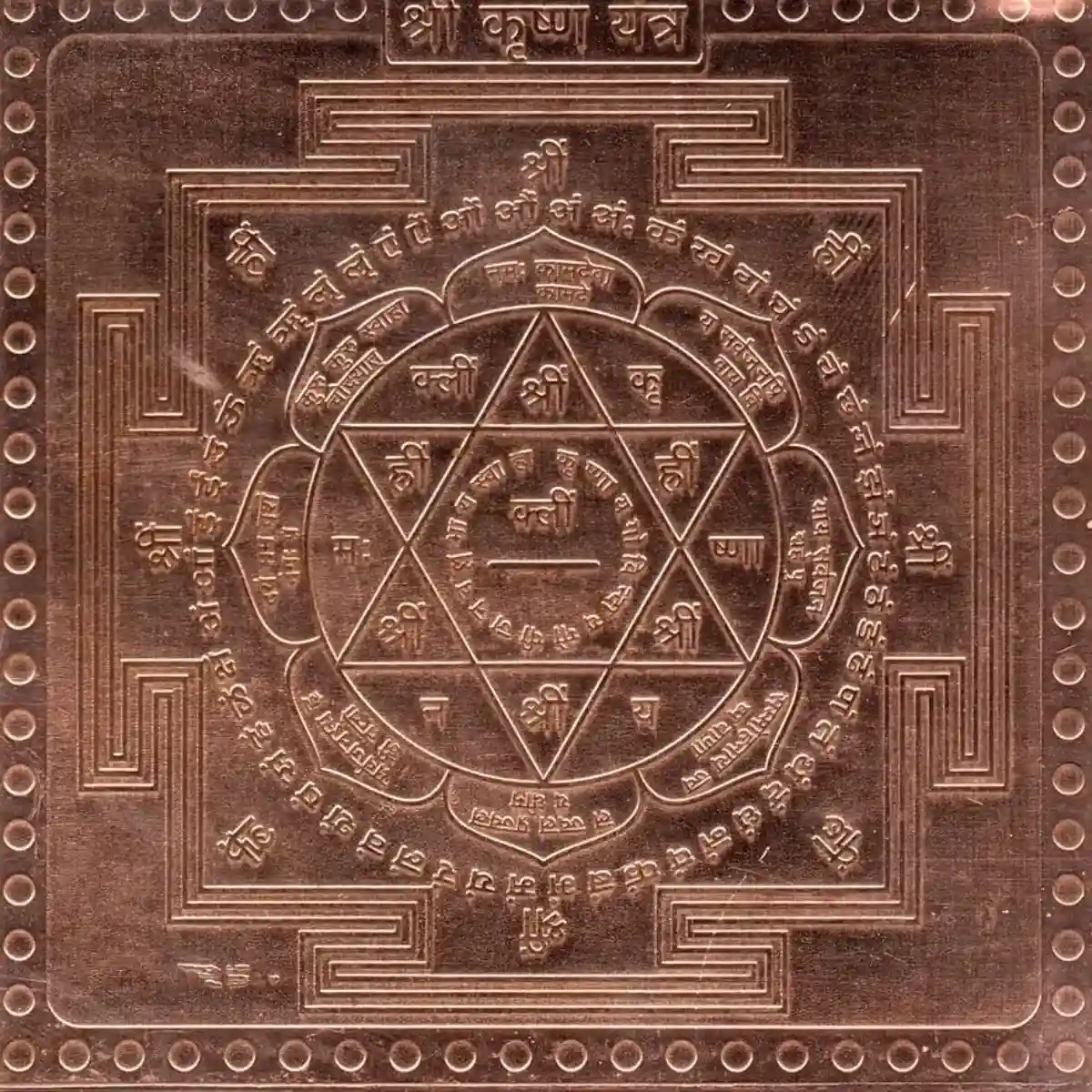
Six-Pointed Star (Shatkona): Union of Purusha and Prakriti
In the Krishna Yantra, the Shatkona formed by the interlocking of an upward and downward triangle, signifies the cosmic union of Shiva (Purusha) and Shakti (Prakriti), in this context, Sri Krishna and Srimati Radha. This union reflects the inseparability of consciousness and energy, of stillness and movement, of divine will and creation.
Vibrational Insight: The interlocked geometry emits a harmonic balance between masculine and feminine polarity, grounding the sadhaka in sacred equilibrium. It acts as a frequency stabilizer that aligns inner chaos with divine symmetry, essential for invoking Sri Krishna’s all-encompassing love.
Central Bindu: The Source of Manifestation
The Bindu at the center represents the Supreme Purusha, Sri Krishna, as the origin point of all creation. It is both void and fullness, the unmanifest that contains everything manifest.
Vibrational Insight: Energetically, the bindu is a spiritual black hole, pulling the consciousness inward, toward the soul’s source. It serves as the seed frequency of divine awareness, helping the devotee merge into Krishna’s inner presence through focused meditation.
Mantras and Syllables: “क्लीं”, “श्रीं”, and “कृष्णाय नमः”
- क्लीं (Kleem) – The beej mantra of attraction and divine magnetism.
- श्रीं (Shreem) – The seed of prosperity, auspiciousness, and beauty.
- कृष्णाय नमः – Surrender to the Supreme Personality of Godhead, Krishna.
Vibrational Insight: These mantras emit sonic blueprints of emotional and spiritual transformation. Kleem enhances magnetic heart-centered energy, Shreem invokes abundant lunar nourishment, and “Krishnaya Namah” aligns the practitioner with the eternal loving intelligence of Krishna consciousness.
When chanted or meditated upon, they restructure subtle energy bodies, bringing the aura into resonance with the divine blueprint of love, abundance, and devotion.
Twelve Petals (Lotus): The Twelve Bhakti Rasas
The twelve-petal lotus surrounding the bindu represents the twelve sacred rasas or emotional flavors through which the devotee relates to Lord Krishna, such as Shanta (peace), Dasya (servitude), Sakhya (friendship), Vatsalya (parental love), and Madhurya (divine romance).
Vibrational Insight: Each petal acts as a spiritual receptor tuned to a specific emotional frequency. Together, they create a spectrum of devotional expression, allowing the sadhaka’s heart to open layer by layer into deeper intimacy with the Divine. This structure mirrors the twelve-petal heart chakra (Anahata) and expands the heart’s electromagnetic field to receive Sri Krishna’s grace more fully.
Sanskrit Ring Around the Yantra: Protective Invocation Field
The Sanskrit letters forming the outer ring act as a vibrational perimeter, a sacred firewall. They invoke Sri Krishna’s divine names and seed syllables that call forth specific aspects of his protection, joy, and guidance.
Vibrational Insight: These syllables create a rotating field of mantra-charged energy, like a spinning disc of protective sound waves. They guard the inner sanctum of the yantra, deflecting negative vibrations, mental distractions, and subtle spiritual interference.
This ring stabilizes the practitioner in the field of Lord Krishna’s divine aura, offering energetic containment, clarity, and upliftment during spiritual practice.
Final Energy Blueprint Summary
Each component of the Sri Krishna Yantra is a fractal of divine intelligence. Together, they form an energetic map of Lord Krishna’s vibration, activating different layers of the sadhaka’s inner and outer being:
- Shatkona: Anchors duality into harmony
- Bindu: Pulls mind into spiritual stillness
- Mantras: Infuses aura with divine code
- Lotus Petals: Awaken pure devotion
- Sanskrit Ring: Shields and empowers
By meditating on this yantra or installing it with devotion, one tunes into the vibrational heart of Sri Krishna, experiencing love that transcends form, time, and space.
Conclusion
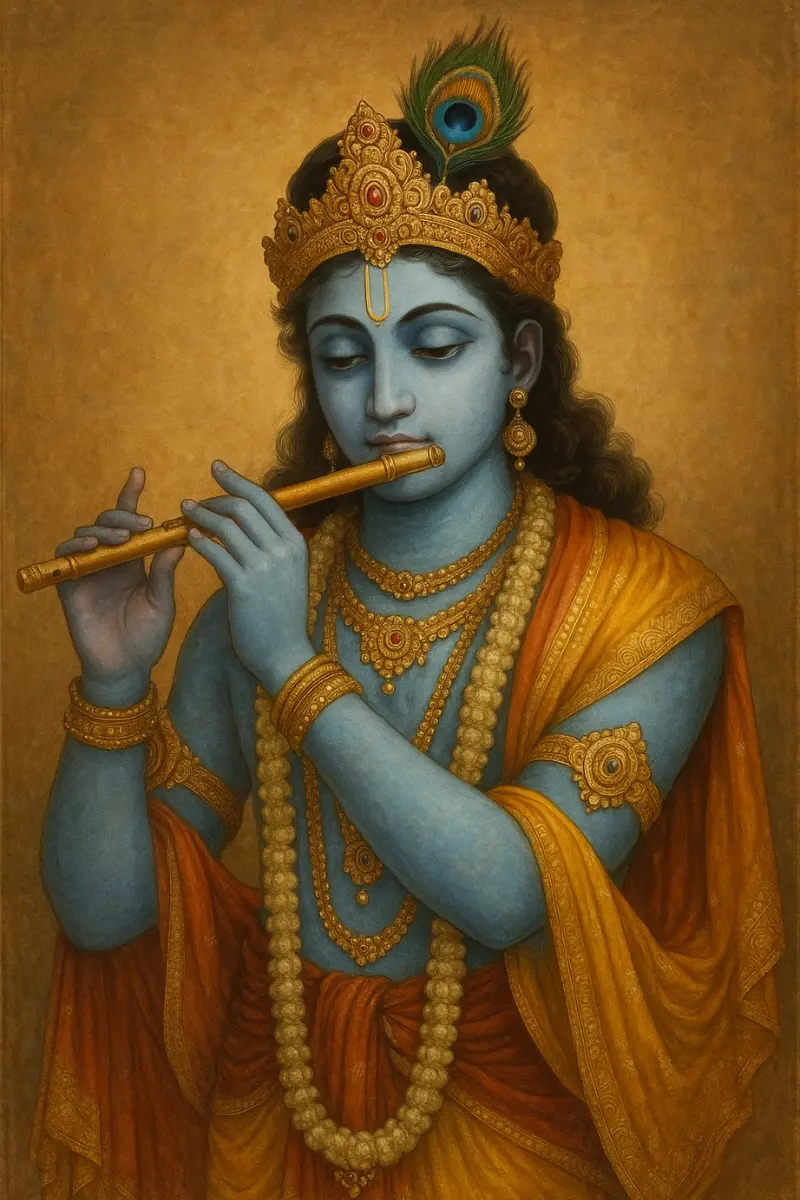
Sri Krishna remains the eternal wellspring of spiritual intelligence, joy, and love. Whether you chant his name, read his words, or meditate on his yantra, he is never distant. For the sincere sadhaka, he is both the goal and the guide. In a world plagued by illusion, deceit, and confusion, may Sri Krishna’s flute awaken your soul toward divine truth.

